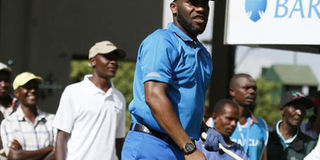Kenya Open history cluttered with great players

Nigeria football legend Augustine “Jay Jay” Okocha follows his tee shot from the 10th tee during the Barclays Kenya Open Pro-Am at Muthaiga Golf Club on March 22, 2017. PHOTO | MARTIN MUKANGU |
What you need to know:
- The staging of the 50th Barclays Kenya Open will be no mean feat.
- In the words of David Jones, the former champion: “A fifty-year history for a golf Open really is something to be proud of.
- To mark the event with the biggest European Challenge Tour purse of 2018 is a great compliment to both the players who have supported it and all the wonderful people who have organised it and kept it going through the years”.
Before the first Kenya Open was held in 1967 at Muthaiga Golf Club, the Kenya Golf Union was keen to invite golf’s greats to come and visit Kenya.
One such golfing legend was Walter Hagen from USA back in 1937 who at the time had two US Open, four Open Championships and five PGA Championships to his name.
In 1951 Bobby Locke, a man many regard as the pioneer champion from South Africa, joined the growing list of champions to visit Kenya. He had already won two Open Championships when he visited Kenya and he went on to win two more after that.
There were many notable champions that visited Kenya when it was still a British colony, and I believe that the exhibition matches played by these greats was the precursor to the Kenya Open in 1967.
Since then, through the Kenya Open, many golfing greats have visited our country. From Seve Ballesteros, Ian Woosnam, Henrik Stenson to Brooks Koepka, all have displayed their skills on Kenyan soil.
For those lucky enough to get an opportunity to participate in the Pro-Am that precedes the main event, it is an opportunity to not only play with these top golfers, but it is also an opportunity to get bragging rights when describing how one played a round of golf with a living legend.
In the 1980s, before it was part of the European Challenge Tour - before the Challenge Tour was even conceived, the Kenya Open was part of the Safari Circuit.
From the 1970s to the 1980s, the Safari Circuit was a major attraction to European Tour golfers who played in Nigeria, Cote d’Ivoire, Zambia and Kenya would form the last part of the tour.
These tournaments would be staged in the early part of the year which was the off-season for the European Tour.
For the European golfers, the Safari Circuit also served as a fund raiser and a morale booster for the tougher European Tour events, but it also helped local golfers in benchmarking. Many players returned over and over to play at the Kenya Open.
One such player was the 1989 Champion, David Jones. He first came to play in the Kenya Open in 1970 and immediately fell in love with the country.
In 1971, with a chance to win, he hit the ball out of bounds on the 18th hole of Muthaiga Golf Club. He publicly vowed that he would return until he won the tournament.
It took him 18 years to get the win. In that time, he made many friends and Kenya had now become a second home to him. He is now a golf course designer and one of his masterpieces is right here:
The first PGA accredited golf course in Africa, the Vipingo Ridge is this week celebrating its 10th anniversary.
I asked David Jones what motivated him and other players to come to play at the Kenya Open and the kind of challenges that they faced then, some that may sound very strange today.
Communications for instance was a major challenge. They had to send letters for their entries and all their other communications. The hosting golf club took charge and sent letters about airport transfers and even organised for members to host some of the players.
They also could not make many phone calls back home as it cost £5 per minute. So before he left home, Jones would give his wife the Muthaiga Golf Club’s postal address. The problem however was in sending letters back to his wife. At times he would get back home long before the letter arrived.
The fact that the Kenya Open was one of the very first African Opens, and its great legacy, attracted great golfers then and still does to date.
In the 1980s, the prize money at the Kenya Open was as much and in some cases, higher than that of many European events.
However due to currency controls, it could fluctuate wildly.
“I recall winning a large cheque for third place in Nigeria, but by the time it got to me… almost four months later, the value had fallen by 70 per cent,” said Jones.
Over the years, the Kenya Open and most other golfing events worldwide have relied on volunteers for their success.
From the board of Kenya Open Golf Limited led by Peter Kanyago, to the marshals headed by Macharia Irungu, to the scoring team guided by Terry Obath, referees, starters and those that will host some of the players in their homes, the Barclays Kenya Open will be run largely by volunteers.
The staging of the 50th Barclays Kenya Open will be no mean feat.
In the words of David Jones, the former champion: “A fifty-year history for a golf Open really is something to be proud of.
To mark the event with the biggest European Challenge Tour purse of 2018 is a great compliment to both the players who have supported it and all the wonderful people who have organised it and kept it going through the years”.




